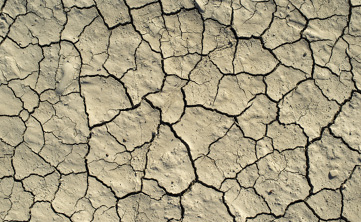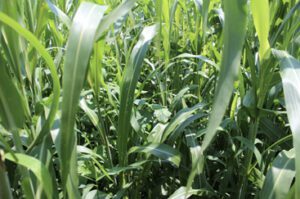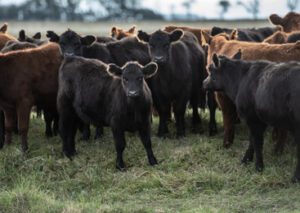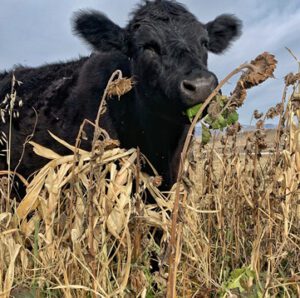
Many farms in the Midwest have gravitated towards a corn-soybean rotation, as the profitability of raising small grains like wheat have stagnated in recent years. One of the big drawbacks of a corn-soybean rotation is that soil quality tends to decline, even under no-till farming. It often becomes quite hard and compacted because the combined months of active plant growth and root exudation between the two crops is only about 7 months out of the 24 month period. Soils devoid of vegetation naturally become compacted due to the simple force of gravity and the compacting action of raindrops, while soil microbes fed by root exudates create aggregation and reverse compaction. After years of only corn and soybeans, soils often become hard as adobe and this is when many farmers give up on no-till, because they can’t get planting equipment to penetrate the soil. This is not a failure of no-till, it is a consequence of an agronomically unsound rotation. Still, it is difficult to justify including the traditional small grain in the rotation, when the cash flow just doesn’t work. However, some farmers have discovered an innovative crop rotation that can create huge soil health benefits in just one calendar year away from corn or soybeans.
I saw this crop rotation in full effect on a visit to South Africa a couple years ago. Farmers would dedicate a full cropping season to a summer annual grazing mix consisting of sorghum-sudangrass, pearl millet, cowpeas, sunn hemp, sunflowers, and buckwheat. The copious root exudates combined with high residue production and manure deposition created an amazing improvement in soil quality in just one season. The following corn or soybean crop would yield so much better than the same crop on neighboring fields in the traditional corn-soybean rotation that the profitability of the rotation simply blew away the traditional rotation, especially after the grazing income was figured in. One farmer I spoke with showed me his Haney soil test results, comparing the systems. The test before the cover crop indicated about 12#/acre of available nitrogen and 9#/acre of available phosphorus.

Photo By: Green Cover
One year later the test a year showed 132#/acre and a staggering 90 #/acre of phosphorus, a testimony to the ability of a diverse summer cover crop to nourish soil microbes that are able to convert previously unavailable forms of phosphorus into lant available forms. It is truly amazing what soil microbes can do when given plenty of food, cover and time. When I spoke about this to farmers in the US, the question they had for me was “How well would that work around here?” The resounding answer among those who have tried it here was near unanimous: EVEN BETTER.
The advantage we have for this rotation in the Midwest and Great Plains regions is that we usually have some winter moisture (unlike South Africa) that makes winter crops feasible in addition to the summer cover crop. Here is what the system could look like
| OPTION 1 Full Season | Option 2 With Wheat Crop | ||
| Fall | Harvest corn/beans | Fall | Harvest corn/beans |
| Fall | Plant rye/trit/vetch/winter peas | Fall | Plant wheat for grain |
| Spring | Graze winter mix | Summer | Harvest wheat for grain |
| Late Spring | Plant warm season mix of sorghum, millet, cowpeas, sunn hemp, buckwheat, sunflowers, etc.. | Summer | Plant warm season mix of sorghum, millet, cowpeas, sunn hemp, buckwheat, sunflowers, etc.. |
| Summer | Rotational graze summer mix | Summer | Graze summer mix |
| Fall | Plant rye/trit/vetch/winter peas | Fall | Plant rye/trit/vetch/winter peas |
| Spring | Plant corn/beans | Spring | Plant corn/beans |
This allows three consecutive cover crops to be grown while sacrificing only one corn or soybean crop, and each of those cover crops can provide valuable grazing while simultaneously improving the soil and the yield of the following cash crops. An alternative option that can work almost as well is to do a similar rotation but using wheat as a cash crop instead of the first rye based grazing crop.
How much grazing? Obviously, this will vary widely among locations depending on soil, weather, and management, but it is common that a well-planned and managed summer grazing crop produces forage to support 200 grazing days per acre for a 1000# animal with excellent animal gains (2.5 – 3.5 ADG is common). To put this in perspective, an acre could carry 400 head of calves weighing 500 pounds apiece, with each gaining over two pounds per day. That is potentially 800 pounds of beef per acre and when a pound of gain generates about $0.80 of income, that is the same gross income (800 x $.80=$640) as 160 bushel corn at $4 a bushel, with far less input costs than a corn crop.

BUT WAIT! There’s more! You can also derive grazing income from the winter grazing crops. Again, grazing income from winter cover crops will obviously vary widely with moisture and winter temperature, but here in the middle of the Plains it is common for a winter grazing crop to support 1000#of live weight per acre for a month or so (more as you go south, less as you go north). If this was two 500#calves per acre gaining two pounds per day, that could add another 240# of gain per acre, or at the same assumption of $.80 per pound of gain $192 more dollars per acre. This can add greatly to the total amount of grazing income above and beyond that derived from the summer grazing crop. Add it all up, and grazing income can compete with grain crops if both are managed well.
Ultimately, while the grazing income is quite nice, what really excites me about this rotation is the typical eye popping increase in the yields of the following corn and soybean crops (I have heard as much as 50% increases, but 10-20% is common); this indicates to me that there is something very, very positive happening belowground when diverse, productive cover crops are properly grazed by livestock in a rotation with cash crops.

Photo By: Philip Frank
This article first appeared in the 8th Edition of Green Cover's Soil Health Resource Guide.
Also check out the 10th edition, our latest Soil Health Resource Guide, over 90 pages packed with scientific articles and fascinating stories from soil health experts, researchers, farmers, innovators, and more! All as our complimentary gift to you, a fellow soil health enthusiast!
